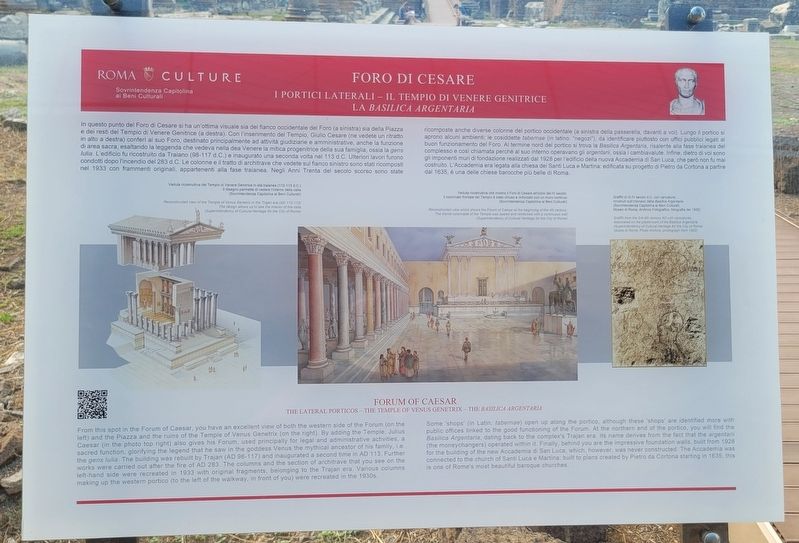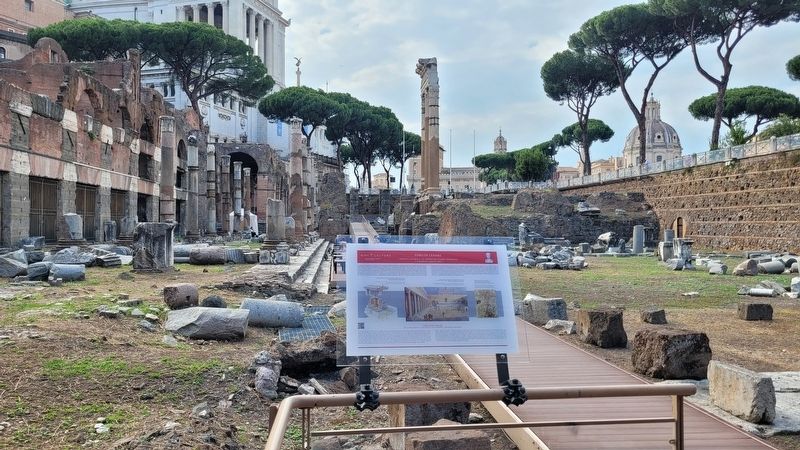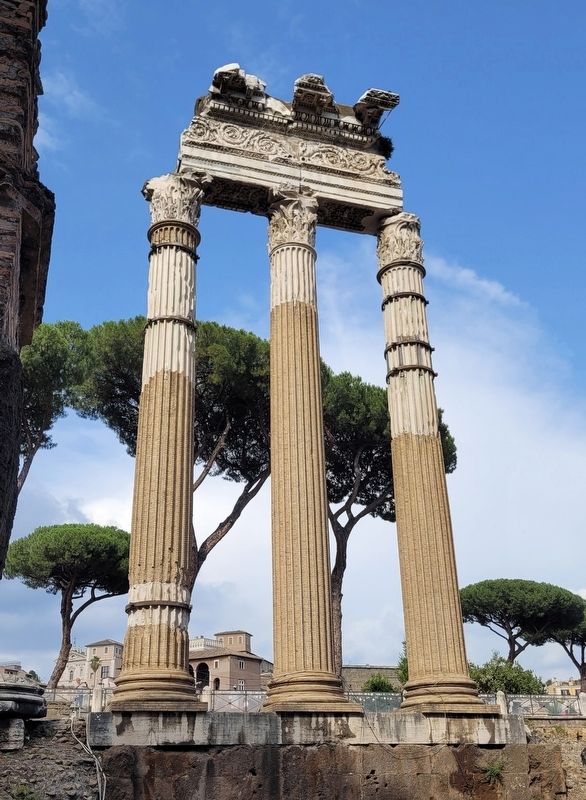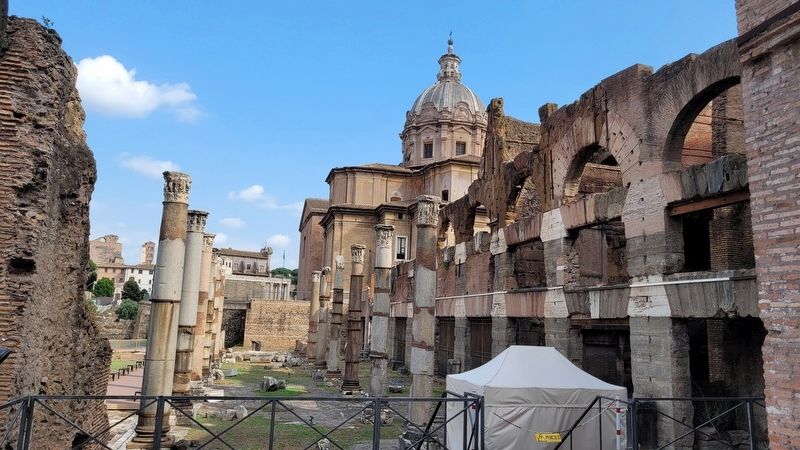Rione X Campitelli in Roma in Città metropolitana di Roma Capitale, Latium, Rome, Italy — Central Italy (Tyrrhenian Coast)
Foro di Cesare / Forum of Caesar
In questo punto del Foro di Cesare si ha un'ottima visuale sia del fianco occidentale del Foro (a sinistra) sia della Piazza e dei resti del Tempio di Venere Genitrice (a destra). Con l'inserimento del Tempio, Giulio Cesare (ne vedete un ritratto in alto a destra) conferi al suo Foro, destinato principalmente ad attività giudiziarie e amministrative, anche la funzione di area sacra, esaltando la leggenda che vedeva nella dea Venere la mitica progenitrice della sua famiglia, ossia la gens Iulia. L'edificio fu ricostruito da Traiano (98-117 d.C.) e inaugurato una seconda volta nel 113 d.C. Ulteriori lavori furono condotti dopo l'incendio del 283 d.C. Le colonne e il tratto di architrave che vedete sul fianco sinistro sono stati ricomposti nel 1933 con frammenti originali, appartenenti alla fase traianea. Negli Anni Trenta del secolo scorso sono state ricomposte anche diverse colonne del portico occidentale (a sinistra della passerella, davanti a voi) Lungo il portico si aprono alcuni ambienti: le cosiddette tabernae (in latino: "negozi"), da identificare piuttosto con uffici pubblici legati al buon funzionamento del Foro. Al termine nord del portico si trova la Basilica Argentaria, risalente alla fase traianea del complesso e così chiamata perché al suo interno operavano gli argentarii, ossia i cambiavalute. Infine, dietro di voi sono gli imponenti muri di fondazione realizzati dal 1928 per l'edificio della nuova Accademia di San Luca, che però non fu mai costruito. L'Accademia era legata alla chiesa dei Santi Luca e Martina: edificata su progetto di Pietro da Cortona a partire dal 1635, è una delle chiese barocche più belle di Roma.
Didascalie
Sinistra: Veduta ricostruttiva del Tempio di Venere Genitrice in età tralanea (112-113 d.C.) Il disegno permette di vedere l'interno della cella (Sovrintendenza Capitolina al Beni Culturali)
Centro: Veduta ricostruttiva che mostra il Foro di Cesare all'inizio del IV secolo. Il colonnato frontale del Tempio è stato chiuso e rinforzato con un muro continuo (Sovrintendenza Capitolina al Beni Culturali)
Destro: Graffiti di III-IV secolo d.C. con caricature, rinvenuti sull'intonaco della Basilica Argentaria (Sovrintendenza Capitolina ai Beni Culturall; Museo di Roma, Archivio Fotografico, fotografia del 1932)
Lateral Porticos - the Temple of Venus
Genetrix - the Basilica Argentaria
From this spot in the Forum of Caesar, you have an excellent view of both the western side of the Forum (on the left) and the Piazza and the ruins of the Temple of Venus Genetrix (on the right). By adding the Temple, Julius Caesar (in the photo top right) also gives his Forum, used principally for legal and administrative activities, a sacred function, glorifying the legend that he saw in the goddess Venus the mythical ancestor of his family, i.e. the gens Iulia. The building was rebuilt by Trajan (AD 98-117) and inaugurated a second time in AD 113. Further works were carried out after the fire of AD 283. The columns and the section of architrave that you see on the left-hand side were recreated in 1933 with original fragments, belonging to the Trajan era. Various columns making up the western portico (to the left of the walkway, in front of you) were recreated in the 1930s.
Some 'shops' (in Latin: tabernae) open up along the portico, although these 'shops' are identified more with public offices linked to the good functioning of the Forum. At the northern end of the portico, you will find the Basilica Argentaria, dating back to the complex's Trajan era. Its name derives from the fact that the argentarii (the moneychangers) operated within it. Finally, behind you are the impressive foundation walls, built from 1928 for the building of the new Accademia di San Luca, which, however, was never constructed. The Accademia was connected to the church of Santi Luca e Martina; built to plans created by Pietro da Cortona starting in 1635, this is one of Rome's most beautiful baroque churches.
Captions
Left: Reconstructed view of the Temple of Venus Genetrix in the Trajan era (AD 112-113) design allows us to see the interior of the cella The Superintendency of Cultural Heritage for the City of Rome)
Center: Reconstructed view which shows the Forum of Caesar at the beginning of the 4th century. The frontal colonnade of the Temple was sealed and reinforced with a continuous wall (Superintendency of Cultural Heritage for the City of Rome)
Right: Graffiti from the 3rd-4th century AD with caricatures, discovered on the plasterwork of the Basilica Argentaria (Superintendency of Cultural Hentage for the City of Rome; Museo di Roma, Photo Archive, photograph from 1932)
Erected by Roma Culture and Sovrintendenza Capitolina ai Beni Culturali.
Topics. This historical marker is listed in these topic lists: Anthropology & Archaeology • Architecture. A significant historical year for this entry is 1933.
Location. 41° 53.613′ N, 12° 29.114′
E. Marker is in Roma, Lazio (Latium, Rome), in Città metropolitana di Roma Capitale. It is in Rione X Campitelli. Marker is on Via dei Fori Imperiali, 0.1 kilometers south of Clivo Argentario. The marker is located along the pathway northwest of the Chiesa Santi Lucae Martina Martiri. Touch for map. Marker is in this post office area: Roma, Lazio 00186, Italy. Touch for directions.
Other nearby markers. At least 8 other markers are within walking distance of this marker. A different marker also named Foro di Cesare / Forum of Caesar (within shouting distance of this marker); Basi Marmoree / Marble Bases (within shouting distance of this marker); Foro di Nerva / Forum of Nerva (about 90 meters away, measured in a direct line); Basilica Aemilia (about 90 meters away); L'Arco di Settimio Severo / The Arch of Septimius Severus (about 90 meters away); Veduta del Tempio di Giove Tonante / View of the Temple of Jupiter Tonans (about 90 meters away); Volcanal (about 120 meters away); Umbilicus Urbis / The Focus of the City (about 120 meters away). Touch for a list and map of all markers in Roma.
More about this marker. The marker is located in the Parco Archeologico del Colosseo (Roman Forum Archaeological Park) and it does require an entry fee to visit.
Also see . . .
1. Il Foro di Cesare. Roma Culture and Sovrintendenza Capitolina ai Beni Culturali (Submitted on November 24, 2023, by James Hulse of Medina, Texas.)
2. Forum of Caesar. Wikipedia
Caesar decided to construct a forum bearing his name in the northeast section of the Forum Romanum, and purchased some very expensive parcels of land in that area (the final cost was said to be 100,000,000 sesterces). Forum construction began probably in 51 BC, although Cicero and Gaius Oppius were entrusted with purchasing the parcels of land on Caesar's behalf as early as 54 BC. On the eve of the Battle of Pharsalus in 48, Caesar vowed a temple to Venus Victrix, the legendary progenitor of his own clan, the gens Iulia. This original dedication was done because she was Pompey's favourite goddess, and Caesar hoped to gain the goddess's favour before the battle against Pompey.(Submitted on November 24, 2023, by James Hulse of Medina, Texas.)
Credits. This page was last revised on November 25, 2023. It was originally submitted on November 24, 2023, by James Hulse of Medina, Texas. This page has been viewed 37 times since then and 11 times this year. Photos: 1, 2, 3, 4. submitted on November 25, 2023, by James Hulse of Medina, Texas.



